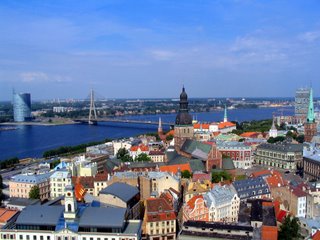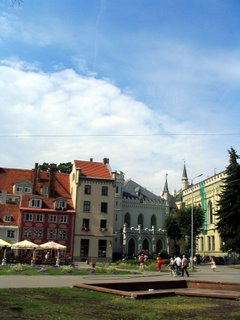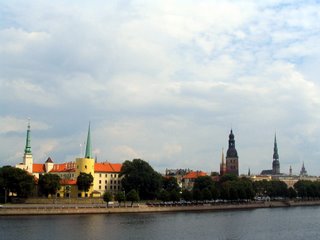I will be leaving Estonia soon, one week to be exact. As is such, I thought that it would be smart to impart my wisdom on all of you who are now thinking of visiting this wonderful country someday, or perhaps evening moving here! The following are a few observations, bits of information, that you may do with as you choose. Enjoy.
1. Bring your own movie collection, or be without the exceptional joy of Movie Night. There are no "Blockbusters" here; no "Family Video". What Estonians have is "Videoplanet". Hardly more than a mom-and-pop shop, it carries about 200 titles (total), 75 of which you can watch in english, about 100 that are on DVD. You have 2 options when using "Videoplanet". One, pay 150 EEK to become a member, renewing your membership every year or half year for 100 EEK, plus the price of rental. Now mind you, that the average person carries between 75-200 EEK on them at anytime (6-18 dollars); most people usually prefer to pay by debit card. Two, offer up a 300 EEK or more deposit, plus price of rental each time you plan on visiting. They only accept cash. I've only seen one branch with an ATM nearby. Four hours later you "may" begin to watch a movie similar to the one you set out for. I believe "Videoplanet" is the reason internet-movie pirating is rampant throughout Estonia.

2. There are no KINKOs in Estonia. We have Printcoopia(s), but they offer a very very tiny selection of jobs. Basically they will duplicate anything...sometimes on colored paper. Unfortunatley, unlike the rest of the country, the workers at Printcoopia(s) do not speak English. This makes words like "collate", "double-sided", and "spiral-bound" sound like gobbledy-gook. Your best bet is to bring a previously prepared example of EXACTLY what you want. Then, cross your fingers and simply smile and be happy with what you recieve. At least it's cheap. My best advice is to make a friends with someone who knows how to say what you want. Oh, and if you must do it alone, be prepared to make several return trips. This one is at least a 2 day ordeal.
3. Get an ISIC card. Despite what the lovely people at Student Travel Agency and Student Universe told me, they still use them here!!! Not only do Estonian turist spots accept these cards, but so do bookstores, some food places, some clothing chains, pharmacies, and transportation. It's good to study and be involved with academia in Estonia.

4. Get used to public transportation. Despite the amount of traffic you will see about you at all times, you will not know ANYONE who has a car...maybe one if you're lucky. They have trams, buses, and trolleys here. They all cost the same (again good to be a student), however, they all ride along with the myriad of cars to their sometimes less than convinient destinations. Thus, traffic problems affect EVERYONE. It's best to walk here if you can...everyone else does.
5. City-wide construction is a free-for-all. This is most heavily done during the summer (when it is dry and warm), however random holes and scaffolding may pop up without warning throughout the year. If there are notices, us foreigners never know(see number 7). Be prepared to walk in the street, sometimes for at least a quarter of your journey. Luckily, the street is oftentimes in better shape than the side-walk anyway.
6. Back to movies. Cinema visits should be a well-coordinated affair. Discuss far in advance. Remember, you must all purchase your movie tickets together as seats are assigned, and not up for questioning or bargaining. If you think you may at all have to go to the bathroom, do it before the movie starts as you will be locked in for the duration of the film. Should you have to leave, you will then be locked out, but the "very nice" door gaurds (if you can find them) will let you back in. Oh, and I recently discovered why Estonians always show up late, or at best, as the movie is starting. Should you arrive early, you must sit through a seemlessly never-ending cycle of the same 4 previews that you must still watch again after the lights dim. These previews also plan throughout the cinema complex as you buy tickets and food. Definatley visit the candyshop.
7. All Estonians know what is going on before you do. I believe they have a collective consciousness that transmits news and gossip as it occurs. You will never have anything of surprise or shock to tell them, do not even try, they already know. They will assume you know too.
8. Be sure to study up on important moments in Estonian history like, "When did Estonia win Eurovision?", "When did Estonia host Eurovision?", "How many times has Estonia been mentioned on The Simpsons?", "What musicians or actors have Estonian roots (this can date back at least 4 generations)?", "When and who has won Olympic medals for Estonia?", "What were the big concerts held in Tallinn for the last 5 years?" , "What did Americans say in response to the question, "where is Estonia?", on some show that happened in the US?". This is a point of departure. The wealth of true-Estonian history is boundless.

9. Bring pants and shoes you do not care about. This only applies to visits during early autumn, winter, and spring. For the other 2 weeks or so, disregard. Your shoes (and the part of the pants that come in contact) will inevitably get ruined as a result of the snow, rain, and muck that develops and lingers here. This is why the shoe industry is so booming in Estonia, and how they can charge such high prices (the highest in the EU). Nevertheless, the sheer volume of white pants and shoes (for both men and women) remains astonishing. They do not have Labor Day, so it's ok to wear white whenever you want.
10. Be prepared to either develope upper-body and core strength, or change your dietary plans as grocery shopping happens one of two ways here. As you will not have a car, nor will anyone you know (of course), you must bag and lug your own food. This keeps the hunter/gatherer instinct alive within you. Your first choice is to either discover exactly how much food you can fit on your person without looking too ridiculous walking back to your apartment (and repeat every 3-4 days), or visit the store everyday as hunger arises. Some places offer to deliver your purchases for you should you spend more than 1000 EEK, though you must plan on spending this amount in advance. The stares and odd-looks you will incure while trying to amass this large quantity of food is hardly worth the convinience of home-delivery.

11. Finally, come with a good sense of humor and adventure. This is a wonderful, charming, unique, and amazing place with clever, kind, and curious (though not always about what you'd think) people. Have a good time! I did :D
 I've been thinking alot about the English Language lately. Now we first must make a distinction between "British" English, and American English. I speak the latter. In Europe, you must be clear on this distinction. Everyone here is taught the British method in school, however they watch American TV and movies, thus usually preferring to speak like me. I am currently at The Vocal Jazz and Pop Days in Soesterberg, The Netherlands (pronounces "Suess-ster-bergch"), where American English is envogue. All day long, conductors (Dutch by birth) comment on how something is pronounced the American way, how we must sing more like Americans, and how in American English, the word is actually spoken thusly... Apparently, this is the international impression of our English:
I've been thinking alot about the English Language lately. Now we first must make a distinction between "British" English, and American English. I speak the latter. In Europe, you must be clear on this distinction. Everyone here is taught the British method in school, however they watch American TV and movies, thus usually preferring to speak like me. I am currently at The Vocal Jazz and Pop Days in Soesterberg, The Netherlands (pronounces "Suess-ster-bergch"), where American English is envogue. All day long, conductors (Dutch by birth) comment on how something is pronounced the American way, how we must sing more like Americans, and how in American English, the word is actually spoken thusly... Apparently, this is the international impression of our English:













